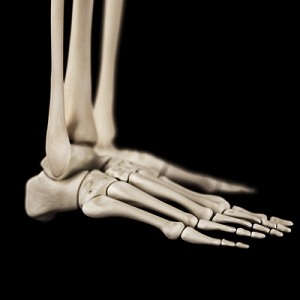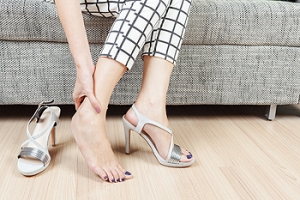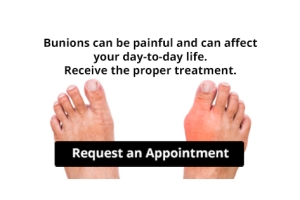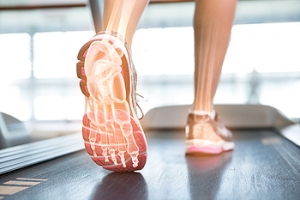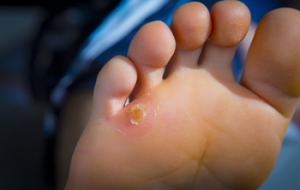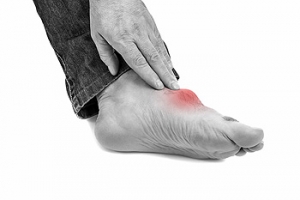
Signs of Cuboid Syndrome
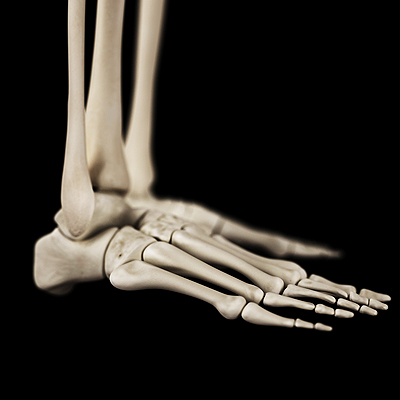 Cuboid syndrome is also referred to as cuboid subluxation. It affects the cuboid bone, which is one of seven tarsal bones that are located in the back and middle area of the foot. This ailment can occur after the patient has endured an ankle injury, or it may happen gradually from overuse. Common symptoms that are generally experienced can include pain and discomfort on the outside of the ankle, and it is often difficult to walk. Additionally, the affected area may appear swollen, and there may be noticeable overpronation. The joint may be manipulated back into its correct position, and wearing orthotics can help to support the arch. If you have foot pain, it is strongly recommended that you seek the counsel of a podiatrist who can properly diagnose and treat cuboid syndrome.
Cuboid syndrome is also referred to as cuboid subluxation. It affects the cuboid bone, which is one of seven tarsal bones that are located in the back and middle area of the foot. This ailment can occur after the patient has endured an ankle injury, or it may happen gradually from overuse. Common symptoms that are generally experienced can include pain and discomfort on the outside of the ankle, and it is often difficult to walk. Additionally, the affected area may appear swollen, and there may be noticeable overpronation. The joint may be manipulated back into its correct position, and wearing orthotics can help to support the arch. If you have foot pain, it is strongly recommended that you seek the counsel of a podiatrist who can properly diagnose and treat cuboid syndrome.
Cuboid syndrome, also known as cuboid subluxation, occurs when the joints and ligaments near the cuboid bone in the foot become torn. If you have cuboid syndrome, consult with one of our podiatrists from The Podiatry Center, PC. Our doctors will assess your condition and provide you with quality foot and ankle treatment.
Cuboid syndrome is a common cause of lateral foot pain, which is pain on the outside of the foot. The condition may happen suddenly due to an ankle sprain, or it may develop slowly overtime from repetitive tension through the bone and surrounding structures.
Causes
The most common causes of cuboid syndrome include:
- Injury – The most common cause of this ailment is an ankle sprain.
- Repetitive Strain – Tension placed through the peroneus longus muscle from repetitive activities such as jumping and running may cause excessive traction on the bone causing it to sublux.
- Altered Foot Biomechanics – Most people suffering from cuboid subluxation have flat feet.
Symptoms
A common symptom of cuboid syndrome is pain along the outside of the foot which can be felt in the ankle and toes. This pain may create walking difficulties and may cause those with the condition to walk with a limp.
Diagnosis
Diagnosis of cuboid syndrome is often difficult, and it is often misdiagnosed. X-rays, MRIs and CT scans often fail to properly show the cuboid subluxation. Although there isn’t a specific test used to diagnose cuboid syndrome, your podiatrist will usually check if pain is felt while pressing firmly on the cuboid bone of your foot.
Treatment
Just as the range of causes varies widely, so do treatments. Some more common treatments are ice therapy, rest, exercise, taping, and orthotics.
If you have any questions, please feel free to contact our office located in Millburn, NJ . We offer the newest diagnostic and treatment technologies for all your foot care needs.
Cuboid Syndrome
Cuboid syndrome mostly affects athletes, although it can affect non-athletes too. It is also known as cuboid subluxation or cuboid fault syndrome. This condition occurs when joints and ligaments near the cuboid bone of the foot are damaged, or when the cuboid bone itself is dislodged from its natural position. It is usually marked by pain on the outer side of the foot, which may be persistent or may come and go. Cuboid syndrome can be difficult to diagnose unless it becomes severe and more noticeable. Your doctor will likely ask questions about when the pain began and how long it has been present, and will put pressure on the cuboid bone to determine if that area is the origin of the pain.
Causes of Cuboid Syndrome
- Any repetitive stresses placed on the foot due to athletic activities are a common cause of cuboid syndrome.
- Although it develops over time, it is possible that this syndrome can occur all of sudden due to a single event or injury.
- Over-pronation can exacerbate the condition if not corrected.
Disagreements Amongst Podiatrists Regarding Cuboid Syndrome
- Some refer to it as the dislocation of the calcaneal-cuboid joint only.
- Other podiatrists see it as an injury of the ligaments located nearby, which also involves the cuboid bone.
It is very important that when you experience any kind of pain on the side of your foot, you should seek medical care right away. If a subluxed cuboid is caught early, your feet may respond well to the treatment, and you can get back into sports or other activities again as soon as the pain subsides.
The Harm in High Heels
 High heels are a wardrobe staple for many, however, wearing high heels can have serious consequences for foot health. A study on foot and ankle injuries in the U.S. found that between 2002 and 2012, U.S. emergency rooms treated 123,355 high heel-related injuries. Strains and sprains of the foot and ankle were the most common of these injuries, and about 20% of them involved broken bones. Another study, this time looking at South Korean flight attendants who were required to wear high heels daily for work, found that their balance decreased over time due to a loss of strength in the muscles and tendons that support the front-to-back movement of the foot. If you do wear high heels, it is recommended that you wear them less frequently, and that you give your feet a break by taking the high heels off to stretch your feet and ankles or by switching to running shoes. For more information on the connection between footwear and foot health, speak with a podiatrist today.
High heels are a wardrobe staple for many, however, wearing high heels can have serious consequences for foot health. A study on foot and ankle injuries in the U.S. found that between 2002 and 2012, U.S. emergency rooms treated 123,355 high heel-related injuries. Strains and sprains of the foot and ankle were the most common of these injuries, and about 20% of them involved broken bones. Another study, this time looking at South Korean flight attendants who were required to wear high heels daily for work, found that their balance decreased over time due to a loss of strength in the muscles and tendons that support the front-to-back movement of the foot. If you do wear high heels, it is recommended that you wear them less frequently, and that you give your feet a break by taking the high heels off to stretch your feet and ankles or by switching to running shoes. For more information on the connection between footwear and foot health, speak with a podiatrist today.
High heels have a history of causing foot and ankle problems. If you have any concerns about your feet or ankles, contact one of our podiatrists from The Podiatry Center, PC. Our doctors can provide the care you need to keep you pain-free and on your feet.
Effects of High Heels on the Feet
High heels are popular shoes among women because of their many styles and societal appeal. Despite this, high heels can still cause many health problems if worn too frequently.
Which Parts of My Body Will Be Affected by High Heels?
- Ankle Joints
- Achilles Tendon – May shorten and stiffen with prolonged wear
- Balls of the Feet
- Knees – Heels cause the knees to bend constantly, creating stress on them
- Back – They decrease the spine’s ability to absorb shock, which may lead to back pain. The vertebrae of the lower back may compress.
What Kinds of Foot Problems Can Develop from Wearing High Heels?
- Corns
- Calluses
- Hammertoe
- Bunions
- Morton’s Neuroma
- Plantar Fasciitis
How Can I Still Wear High Heels and Maintain Foot Health?
If you want to wear high heeled shoes, make sure that you are not wearing them every day, as this will help prevent long term physical problems. Try wearing thicker heels as opposed to stilettos to distribute weight more evenly across the feet. Always make sure you are wearing the proper shoes for the right occasion, such as sneakers for exercising. If you walk to work, try carrying your heels with you and changing into them once you arrive at work. Adding inserts to your heels can help cushion your feet and absorb shock. Full foot inserts or metatarsal pads are available.
If you have any questions please feel free to contact our office located in Millburn, NJ . We offer the newest diagnostic and treatment technologies for all your foot and ankle needs.
Effect of High Heels on the Feet
High heels are uncomfortable, but many women sacrifice comfort to be stylish. There are many problems that stem from wearing high heels, however these issues can be avoided by wearing proper shoes.
Heels are bad because they push your weight forward toward the fall of the foot. The higher the heel is, the more weight and pressure get shifted. This process causes the back to hyperextend backwards to counterbalance which may cause pain in the leg, hip, and back. Consequently, major posture problems may occur, and these issues may eventually become permanent.
Wearing high heels is one of the leading cause of ingrown toenails. Heels create a great deal of pressure on the big toenails which disrupts proper toenail growth. This may eventually lead to the big toenail growing into the skin. Another common problem that stems from high heels is bunions. If bunions go untreated, they can cause serious scar tissue to form along with severe pain.
However, there are ways to minimize the harmful risks associated with wearing heels. You should try to massage and stretch your legs and feet after wearing heels for an extended time. Stretching helps prevent the Achilles tendons and calf muscles from becoming too tight. A good substitute for heels are platforms which provide a better surface area to evenly distribute the body’s weight.
If you are experiencing any painful foot conditions from wearing high heels, you should consult with your podiatrist right away.
Are Bunions Affecting Your Everyday Life?
Poor Foot Biomechanics
 There are a variety of biomechanical issues in the feet that can lead to potential injury. Some of these issues include fallen arches, over-pronation, or supination. Pronation occurs when the foot rolls inward at the ankle, the midfoot bulges and the arch flattens. Supination occurs when the foot rolls out at the ankle and the arch is raised, which leads to issues absorbing shock. When poor foot biomechanics can cause specific foot injuries such as plantar fasciitis, Achilles tendonitis, or a Morton’s neuroma, pain in the ankles, heels, and arches is a common result. Poor foot biomechanics can also lead to issues in other parts of the body that include knee pain, hip pain, shin splints and lower back pain. If you are concerned about your foot biomechanics, consult with a podiatrist.
There are a variety of biomechanical issues in the feet that can lead to potential injury. Some of these issues include fallen arches, over-pronation, or supination. Pronation occurs when the foot rolls inward at the ankle, the midfoot bulges and the arch flattens. Supination occurs when the foot rolls out at the ankle and the arch is raised, which leads to issues absorbing shock. When poor foot biomechanics can cause specific foot injuries such as plantar fasciitis, Achilles tendonitis, or a Morton’s neuroma, pain in the ankles, heels, and arches is a common result. Poor foot biomechanics can also lead to issues in other parts of the body that include knee pain, hip pain, shin splints and lower back pain. If you are concerned about your foot biomechanics, consult with a podiatrist.
If you have any concerns about your feet, contact one of our podiatrists from The Podiatry Center, PC. Our doctors can provide the care you need to keep you pain-free and on your feet.
Biomechanics in Podiatry
Podiatric biomechanics is a particular sector of specialty podiatry with licensed practitioners who are trained to diagnose and treat conditions affecting the foot, ankle and lower leg. Biomechanics deals with the forces that act against the body, causing an interference with the biological structures. It focuses on the movement of the ankle, the foot and the forces that interact with them.
A History of Biomechanics
- Biomechanics dates back to the BC era in Egypt where evidence of professional foot care has been recorded.
- In 1974, biomechanics gained a higher profile from the studies of Merton Root, who claimed that by changing or controlling the forces between the ankle and the foot, corrections or conditions could be implemented to gain strength and coordination in the area.
Modern technological improvements are based on past theories and therapeutic processes that provide a better understanding of podiatric concepts for biomechanics. Computers can provide accurate information about the forces and patterns of the feet and lower legs.
Understanding biomechanics of the feet can help improve and eliminate pain, stopping further stress to the foot.
If you have any questions please feel free to contact our office located in Millburn, NJ . We offer the newest diagnostic and treatment technologies for all your foot and ankle needs.
The Importance of Biomechanics in Podiatry
Biomechanics and its related study deal with the forces that act against the body and affect things like our movement. In podiatry, biomechanics are studied to determine the movement of the ankle, toes, and the foot, as well as the forces that impact them. Podiatrists who train in this specialty are able to effectively diagnose and treat conditions that affect people’s everyday movement.
Regardless of your lifestyle, age, or any other factors, many people experience foot problems throughout their lives. Twists and turns, improper balance, and added weight are just a few of the things that can add stress to the feet. These issues can also limit our bodies’ mobility that we often take for granted. Pain in the feet and ankles can also trickle up towards the lower legs, knees, hip, and even back area. This affects the way you move around on a daily basis.
Biomechanics and its related study deal with forces that act against the body and affect things like our movement. In podiatry, biomechanics are studied to determine the movement of the ankle, toes, and the foot, as well as the forces that impact them. Podiatrists who train in this specialty are able to effectively diagnose and treat conditions that affect people’s everyday movement.
Regardless of your lifestyle, age, or any other factors, many people experience foot problems throughout their lives. Twists and turns, improper balance, and added weight are just a few of the things that can add stress to the feet. These issues can also limit our bodies’ mobility that we often take for granted. Pain in the feet and ankles can also trickle up towards the lower legs, knees, hip, and even back area. This affects the way you move around on a daily basis.
The history of studying biomechanics dates back to ancient Egypt at around 3000 B.C., where evidence of professional foot care has been recorded. Throughout the centuries, advances in technology, science, and an understanding of the human body led to more accurate diagnosis of conditions such as corns for example. In 1974, biomechanics garnered a large audience when Merton Root founded Root Lab to make custom orthotics. He proposed that corrections of certain conditions could be implemented to gain strength and coordination in the area. Due to his research, we still use his basic principle of foot orthotics to this day.
As technology has improved, so have the therapeutic processes that allow us to correct deficiencies in our natural biomechanics. Computers can now provide accurate readings of the forces, movements, and patterns of the foot and lower leg. Critical treatment options can be provided to patients now who suffer from problems that cause their biomechanics to not function naturally. The best results are now possible thanks to 3D modeling and computing technologies that can take readings and also map out what treatment will do to the affected areas.
These advanced corrective methods were able to come to light thanks to an increase in both the technologies surrounding biomechanics and also the knowledge of how they work naturally. For example, shoe orthotics are able to treat walking inabilities by realigning the posture deviations in patients caused by hip or back problems. Understanding foot biomechanics can help improve movement and eliminate pain, stopping further stress to the foot. Speak with your podiatrist if you have any of these problems.
There Are Two Types of Corns
 A small area of thickened skin on the bottom of the foot may indicate a hard corn. It generally develops as a result of excess friction that can come from wearing shoes and socks that do not fit correctly. A corn can form between the toes, and this is referred to as a soft corn. It can be quite painful, and it may feel better to wear a corn pad over the affected area. This can help the corn to gradually reduce in size, and mild relief may be felt when larger size shoes are worn, as they can diminish excess friction. For corns that are severe, salicylic acid may be applied to the affected area, and the corn will eventually be removed. Corns can be quite bothersome, and if you are afflicted with hard or soft corns, it is recommended that you consult with a podiatrist.
A small area of thickened skin on the bottom of the foot may indicate a hard corn. It generally develops as a result of excess friction that can come from wearing shoes and socks that do not fit correctly. A corn can form between the toes, and this is referred to as a soft corn. It can be quite painful, and it may feel better to wear a corn pad over the affected area. This can help the corn to gradually reduce in size, and mild relief may be felt when larger size shoes are worn, as they can diminish excess friction. For corns that are severe, salicylic acid may be applied to the affected area, and the corn will eventually be removed. Corns can be quite bothersome, and if you are afflicted with hard or soft corns, it is recommended that you consult with a podiatrist.
Corns can make walking very painful and should be treated immediately. If you have questions regarding your feet and ankles, contact one of our podiatrists of The Podiatry Center, PC. Our doctors will treat your foot and ankle needs.
Corns: What Are They? And How Do You Get Rid of Them?
Corns are thickened areas on the skin that can become painful. They are caused by excessive pressure and friction on the skin. Corns press into the deeper layers of the skin and are usually round in shape.
Ways to Prevent Corns
There are many ways to get rid of painful corns such as:
- Wearing properly fitting shoes that have been measured by a professional
- Wearing shoes that are not sharply pointed or have high heels
- Wearing only shoes that offer support
Treating Corns
Although most corns slowly disappear when the friction or pressure stops, this isn’t always the case. Consult with your podiatrist to determine the best treatment option for your case of corns.
If you have any questions please feel free to contact our office located in Millburn, NJ . We offer the newest diagnostic and treatment technologies for all your foot and ankle needs.
Understanding Corns and Calluses
Corns and Calluses are both hardened layers of thickened skin that develop because of friction. Both ailments are typically found on the feet and may be unsightly. Although they have similarities, corns and calluses are different from each other.
Some causes of corns and calluses may be wearing ill-fitting shoes and not wearing socks. If you wear tight shoes, your feet will constantly be forced to rub against the shoes, causing friction. If you fail to wear socks, you are also causing your feet to endure excess friction.
There are some signs that may help you determine whether you have one of these two conditions. The first symptom is a thick, rough area of skin. Another common symptom is a hardened, raised bump on the foot. You may also experience tenderness or pain under the skin in addition to flaky, dry, or waxy skin.
There are also risk factors that may make someone more prone to developing corns and calluses. If you are already dealing with bunions or hammertoe, you may be more vulnerable to having corns and calluses as well. Other risk factors are foot deformities such as bone spurs, which can cause constant rubbing inside the shoe.
Corns tend to be smaller than calluses and they usually have a hard center surrounded by inflamed skin. They also tend to develop on the parts of the body that don’t bear as much weight such as the tops and sides of toes. Corns may also be painful for those who have them. On the other hand, calluses are rarely painful. These tend to develop on the bottom of the feet and may vary in size and shape.
Fortunately, most people only need treatment for corns and calluses if they are experiencing discomfort. At home treatments for corns and calluses should be avoided, because they will likely lead to infection. If you have either of these ailments it is advised that you consult with your podiatrist to determine the best treatment option for you.
When Gout Is Not Getting Better
Gout is a type of arthritis caused by a buildup of uric acid in the bloodstream. The uric acid deposits in the joints, usually those of the big toe, and forms crystals, which lead to pain, redness, and swelling in the joint. There are various treatments for gout, but what if none of them are working for you? There is a possibility that you may not have gout. Pseudogout, a condition that mimics gout but causes calcium crystals to build up in the joints instead of uric acid crystals, may be the real culprit. It is also possible that you may have a different type of arthritis, such as reactive arthritis, psoriatic arthritis, infectious arthritis, chronic rheumatoid arthritis, or chronic osteoarthritis. For more information about gout, conditions that might mimic it, and treatment recommendations, consult with a podiatrist.
Gout is a foot condition that requires certain treatment and care. If you are seeking treatment, contact one of our podiatrists from The Podiatry Center, PC. Our doctors will treat your foot and ankle needs.
What Is Gout?
Gout is a type of arthritis caused by a buildup of uric acid in the bloodstream. It often develops in the foot, especially the big toe area, although it can manifest in other parts of the body as well. Gout can make walking and standing very painful and is especially common in diabetics and the obese.
People typically get gout because of a poor diet. Genetic predisposition is also a factor. The children of parents who have had gout frequently have a chance of developing it themselves.
Gout can easily be identified by redness and inflammation of the big toe and the surrounding areas of the foot. Other symptoms include extreme fatigue, joint pain, and running high fevers. Sometimes corticosteroid drugs can be prescribed to treat gout, but the best way to combat this disease is to get more exercise and eat a better diet.
If you have any questions please feel free to contact our office located in Millburn, NJ . We offer the newest diagnostic and treatment technologies for all your foot and ankle needs.
